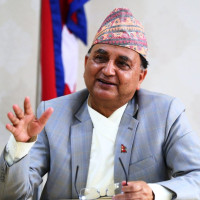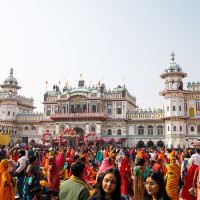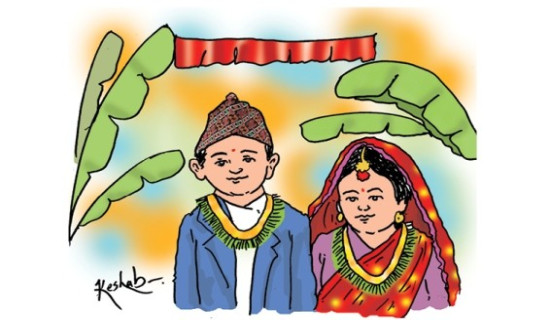- Tuesday, 25 November 2025
Constitutionalism And Democracy In Nepal
Constitutionalism and democracy are complementary concepts. Democracy has been defined as a form of government where the people's elected representatives rule, while constitutionalism underscores that governments must rule within the constitutional framework. For a country to have a vibrant democracy, it must have a constitution. Almost all world countries, except Britain, have a written constitution. The British constitution is based on conventions, court judgements, precedence, and international laws. A constitution is an indispensable instrument for the legitimacy of a government, but it does not mean that a constitution presupposes the existence of democracy.
In the simplest form, a constitution is a set of legal codes that have evolved over centuries from primitive society to modern times. In primitive societies, simple rules such as equal access to food, protection, and obligation to specific social functions bound the community together. The voluntary subjection to these rules had separated them from the rest of the animals. This also constituted a leap for them toward a civilised life.
Over the millennia, these rules were perfected and homogenised as norms of social behaviour. As human society became organised and statehood emerged, more critical, time-tested, and contextual rules started to be codified. The first written legal code is considered to be the Code of Hammurabi (1754 BCE). It is so called because Hammurabi, a king of the Babylonian Dynasty, enacted it.
Despite being the first ever written code, the Code of Hammurabi was not a constitution. It was only a penal code dealing with criminal justice. For any legal code to become a constitution, it should define directive principles, specify the structure of the government, designate the location of power, safeguard the rights of the citizens, specify their duties, and, above all, it must have provisions to hold state functionaries accountable for their actions. The constitution is the supreme legal document of a country. It is promulgated either by the highest authority in the case of a unitary state or by an elected parliament in the case of a federal or republican democracy. Nepal's constitution has been prepared and promulgated by the constituent assembly.
From a historical perspective, the Constitution of Medina (622 CE) is considered the world's oldest written constitution. The Constitution of San Marino (1600) is the second oldest constitution, while the Constitution of the United States (1787) is considered the third oldest written constitution. Many countries of the world have a history of prolonged struggle for enshrining the rights of their people. Britain fought for 474 years, counting from the Magna Carta (1215) to the Glorious Revolution (1688) for parliamentary supremacy. The passage of the Bill of Rights in 1689 enshrined parliamentary sovereignty in the constitution once and for all.
In modern times, Nepal is recognised as a country that has fought for the longest time to have a constitution with widespread endorsement. The fight lasted for 65 years, from the 1950 revolution to 2015, when Nepal's Constituent Assembly proclaimed the constitution, which introduced the federal democratic republican system in the country. Generally speaking, a constitution is an instrument for achieving good governance, the rule of law, and social justice, which are necessary for ensuring stability in the country and the welfare of the people.
The Government of Nepal Act 1948, promulgated by Padma Shamsher, was the first constitution of Nepal. However, this constitution did not meet the people's expectations for a broad political change. As a result, a massive people's movement broke out two years later, overthrowing the Rana Oligarchy and introducing democracy in Nepal.
A cursory look at Nepal's political history reveals that the 1950 revolution was the first significant milestone in the struggle to end the country's dynastic rule. The revolution was also the first platform to articulate the demand for a constituent assembly. After the revolution of 1950, the newly formed communist parties raised the demand for the constituent assembly election. Late King Tribhuvan had promised to hold a constituent assembly election in his address, delivered in the nation's name. But his son Mahendra backed down from the promise when Tribhuvan died in 1955. Instead, the late King Mahendra held a parliamentary election in 1959. The Nepali Congress formed the government by winning the majority, but its 18-month-long rule ended in the coup by King Mahendra. The king promulgated the Constitution of Nepal in 1963, introducing a party-less Panchayat system. This step set the country on the path of confrontation, which lasted for 30 years till a mass people's movement overthrew the absolute monarchy in 1990.
In 1991, a first-ever international seminar was held in Nepal on constitutionalism with the representation of famous constitutional experts like P.N. Bhagwati from India, Dorab Patel from Pakistan, Father William Timm from Bangladesh, Basudev Dhungana and Daman Nath Dhungana from Nepal. The election for a constituent assembly was mooted, but eventually, there was consensus to hold a parliamentary election and to draft a constitution by a Constitution Drafting Recommendation Commission. As expected, the Constitution of 1991 was promulgated by the king, who accepted the status of constitutional monarchy but retained enough power and privileges for himself and his family.
Repeated failure in getting a constitution drafted by a constituent assembly and the compromising attitudes of the Nepali Congress and CPN (UML) toward monarchy allowed the Maoists to legitimise their armed revolt, which they launched in 1996, resulting in the death of 17000 people and the displacement of hundreds of thousands of others.
The 12-point agreement signed on 22 April 2005 and the Comprehensive Peace Agreement signed on 21 November 2006 ended the 10-year-long insurgency. The parliament comprising the existing members and the coopted representatives of the CPN (Maoist) abolished the monarchy and declared Nepal a federal democratic republican country in 2008. This parliament also decided to draft a constitution through a constituent assembly. It was a defining moment in the constitutional history of Nepal.
Nepal's struggle for constitutionalism came to a successful conclusion on 22 September 2015, when the Constitution of Nepal 2015 was promulgated. Unfortunately, our country faces political instability, lack of good governance, ubiquitous corruption, and failure to deliver welfare and service to the people even under the new constitution. The dissenting voices on the issues of identity, citizenship, minority representation, untouchability, and inclusion still resonate in society. The present coalition government has come to power with the declared goal to amend the constitution. It should live up to its promise by taking bold steps to introduce necessary amendments to broaden the acceptability and ownership of the constitution so that the 65-year-long struggle of the Nepali people for a popularly endorsed democratic constitution will not go in vain.
(Dr. Bharadwaj is a former ambassador and former chairperson of Gorkhapatra Corporation bharadwajnarad@gmail.com)
















